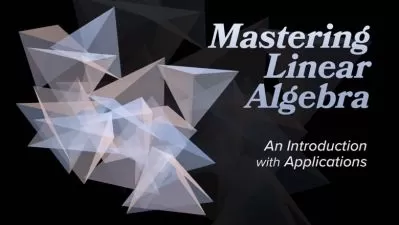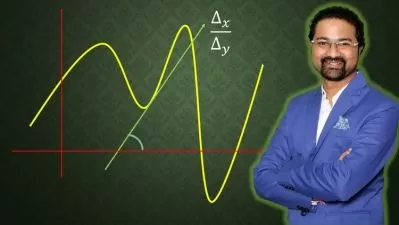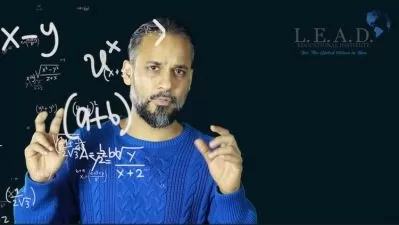Calculus: Complete Course
Woody Lewenstein
20:05:08
Description
From Beginner to Expert - Calculus Made Easy, Fun and Beautiful
What You'll Learn?
- Differentiation
- Integration
- Differential Equations
- Optimization
- Chain Rule, Product Rule, Quotient Rule
- Limits
- Maclaurin and Taylor Series
Who is this for?
What You Need to Know?
More details
DescriptionThis is course designed to take you from beginner to expert in calculus. It is designed to be fun, hands on and full of examples and explanations. It is suitable for anyone who wants to learn calculus in a rigorous yet intuitive and enjoyable way.
The concepts covered in the course lie at the heart of other disciples, like machine learning, data science, engineering, physics, financial analysis and more.
Videos packed with worked examples and explanations so you never get lost, and many of the topics covered are implemented in Geogebra, a free graphing software package.
Key concepts taught in the course are:
Differentiation Key Skills: learn what it is, and how to use it to find gradients, maximum and minimum points, and solve optimisation problems.
Integration Key Skills: learn what it is, and how to use it to find areas under and between curves.
Methods in Differentiation: The Chain Rule, Product Rule, Quotient Rule and more.
Methods in Integration: Integration by substitution, by parts, and many more advanced techniques.
Applications of Differentiation: L'Hopital's rule, Newton's method, Maclaurin and Taylor series.
Applications in Integration: Volumes of revolution, surface areas and arc lengths.
Alternative Coordinate Systems: parametric equations and polar curves.
1st Order Differential Equations: learn a range of techniques, including separation of variables and integrating factors.
2nd Order Differential Equations: learn how to solve homogeneous and non-homogeneous differential equations as well as coupled and reducible differential equations.
Much, much more!
The course requires a solid understanding of algebra. In order to progress past the first few chapters, an understanding of trigonometry, exponentials and logarithms is useful, though I give a brief introduction to each.
Please note: This course is not linked to the US syllabus Calc 1, Calc 2 & Calc 3 courses, and not designed to prepare you specifically for these. The course will be helpful for students working towards these, but that's not the aim of this course.
Who this course is for:
- Data scientists
- People studying calculus
- Engineers
- Financial analysts
- Anyone looking to expand their knowledge of mathematics
This is course designed to take you from beginner to expert in calculus. It is designed to be fun, hands on and full of examples and explanations. It is suitable for anyone who wants to learn calculus in a rigorous yet intuitive and enjoyable way.
The concepts covered in the course lie at the heart of other disciples, like machine learning, data science, engineering, physics, financial analysis and more.
Videos packed with worked examples and explanations so you never get lost, and many of the topics covered are implemented in Geogebra, a free graphing software package.
Key concepts taught in the course are:
Differentiation Key Skills: learn what it is, and how to use it to find gradients, maximum and minimum points, and solve optimisation problems.
Integration Key Skills: learn what it is, and how to use it to find areas under and between curves.
Methods in Differentiation: The Chain Rule, Product Rule, Quotient Rule and more.
Methods in Integration: Integration by substitution, by parts, and many more advanced techniques.
Applications of Differentiation: L'Hopital's rule, Newton's method, Maclaurin and Taylor series.
Applications in Integration: Volumes of revolution, surface areas and arc lengths.
Alternative Coordinate Systems: parametric equations and polar curves.
1st Order Differential Equations: learn a range of techniques, including separation of variables and integrating factors.
2nd Order Differential Equations: learn how to solve homogeneous and non-homogeneous differential equations as well as coupled and reducible differential equations.
Much, much more!
The course requires a solid understanding of algebra. In order to progress past the first few chapters, an understanding of trigonometry, exponentials and logarithms is useful, though I give a brief introduction to each.
Please note: This course is not linked to the US syllabus Calc 1, Calc 2 & Calc 3 courses, and not designed to prepare you specifically for these. The course will be helpful for students working towards these, but that's not the aim of this course.
Who this course is for:
- Data scientists
- People studying calculus
- Engineers
- Financial analysts
- Anyone looking to expand their knowledge of mathematics
User Reviews
Rating
Woody Lewenstein
Instructor's Courses
Udemy
View courses Udemy- language english
- Training sessions 116
- duration 20:05:08
- Release Date 2024/06/21
















